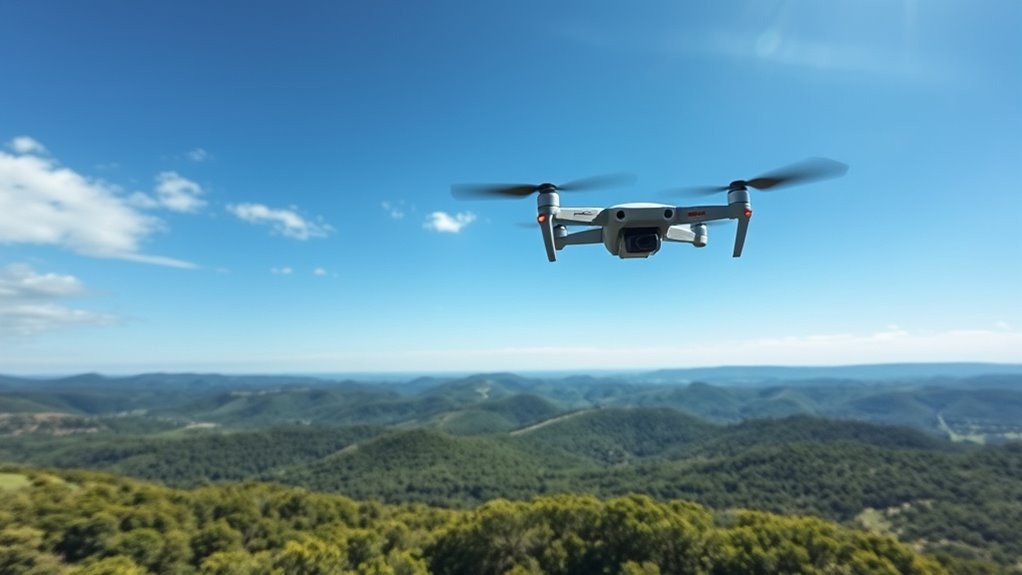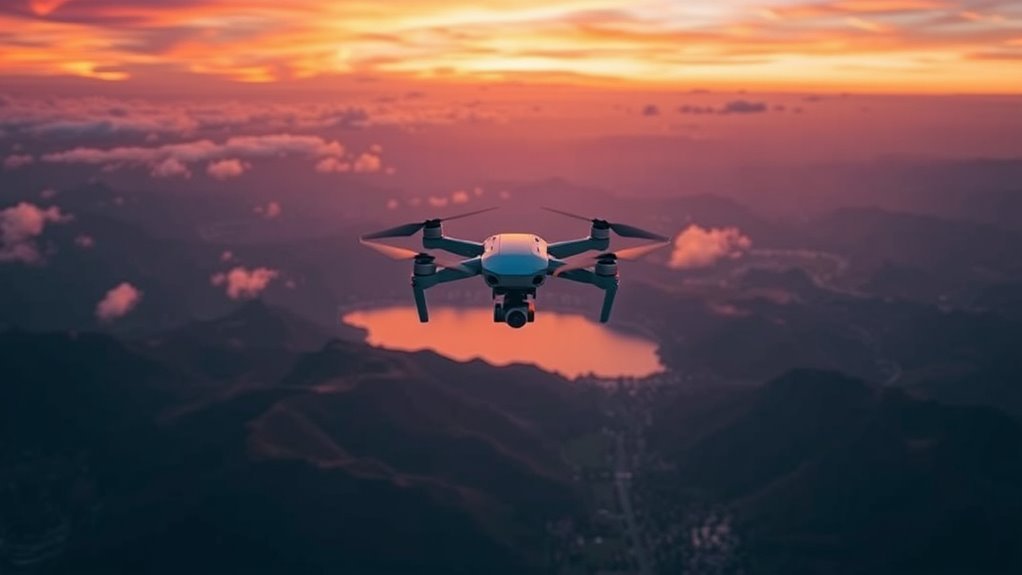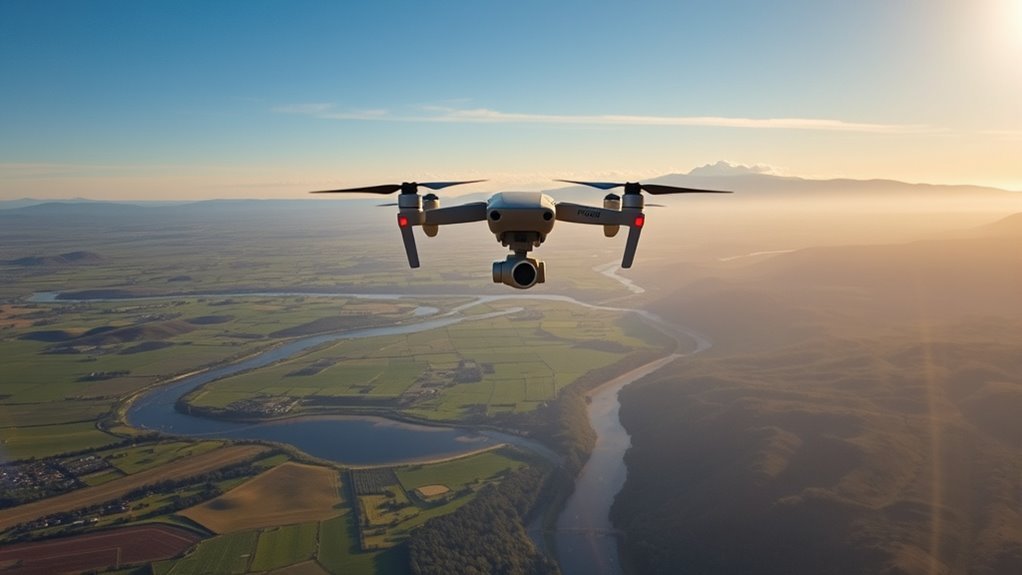You can legally fly your drone up to 400 feet above ground level, as per FAA regulations. However, local laws might impose stricter altitude limits and designate no-fly zones that you need to comply with. Make sure you’ve registered your drone and obtained necessary certifications before operating. Additionally, it’s essential to stay informed about any changes in regulations that could affect your drone flights. There’s more to learn about maintaining compliance and safety in your drone operations.
Overview of Drone Regulations

As drone technology has rapidly advanced, understanding the regulations governing their use has become essential for operators. Familiarizing yourself with drone certification is important, as it guarantees compliance with national and local laws. Certifications often require passing specific tests and demonstrating safe flying practices. Additionally, drone insurance is critical; it protects you from potential liabilities that could arise during operations. Many jurisdictions mandate insurance coverage, so you’ll want to investigate the requirements in your area. By following these regulations, you not only safeguard your investment but also promote responsible drone usage. Staying informed about evolving rules guarantees you can enjoy the freedom of flying while minimizing risks and legal repercussions. Furthermore, understanding local regulations is crucial to ensure safe and compliant drone operations. In Iceland, for example, registration with the Icelandic Transport Authority is mandatory for drones over 250 grams, highlighting the importance of adhering to specific national guidelines.
Understanding Altitude Limits

To understand altitude limits for your drone, you need to be aware of Federal Aviation Administration regulations, which set a maximum flight height of 400 feet above ground level in most cases. Additionally, local airspace restrictions and special use airspace can impose further limitations on where and how high you can fly. Staying informed about these factors is essential for compliant and safe drone operation.
Federal Aviation Administration Regulations
Understanding the altitude limits set by the Federal Aviation Administration (FAA) is essential for anyone operating a drone. As a drone pilot, you must comply with regulations to guarantee safety and legality. Here are some key points to remember:
- You can fly your drone up to 400 feet above ground level.
- If you’re flying near a building, you may go up to 400 feet above that structure.
- Drone registration and pilot certification are mandatory for flying legally.
Local Airspace Restrictions
Local airspace restrictions can greatly affect how high you can legally fly your drone. It’s important to familiarize yourself with local ordinances, as they often impose altitude limits that differ from federal regulations. For instance, some municipalities may restrict drone flights over parks, schools, or residential areas, greatly reducing your operational ceiling. To navigate these restrictions effectively, utilize airspace mapping tools that provide up-to-date information about local regulations. These resources help you identify any no-fly zones or specific altitude limits within your area. By staying informed and compliant with local laws, you can enjoy the freedom of flying your drone while respecting the rules set forth to promote public safety and privacy. Always check for updates, as regulations can change.
Special Use Airspace
While many drone operators may be aware of general altitude limits, special use airspace introduces additional complexities that can restrict where you can fly. Understanding airspace types is essential for maintaining compliance and ensuring safety.
Consider these important factors regarding special use airspace:
- Restricted Areas: These zones may prohibit drone flights altogether or require special permissions.
- Prohibited Areas: Flight is completely banned in these spaces, often for national security or safety reasons.
- Warning Areas: While you may fly here, be cautious of potential hazards, such as military activities.
National Regulations by Country

As drone usage continues to rise globally, it’s essential to recognize that regulations vary considerably from one country to another. Different nations implement international drone policies that govern flight altitude, operational zones, and safety protocols. For instance, some countries require drone registration, imposing specific drone registration requirements before you can take to the skies. In the U.S., you must register drones weighing over 0.55 pounds, while in Canada, there are distinct classifications based on weight and purpose. Countries in Europe often follow EU regulations, which include mandatory training and registration. Understanding these national regulations is vital for ensuring that you fly your drone legally and responsibly, maximizing your freedom while minimizing risks.
Local and Municipal Drone Laws
Understanding local and municipal drone laws is vital, especially since these regulations can impose additional restrictions beyond national guidelines. Before you take flight, it’s important to be aware of specific local requirements that may affect your freedom to operate. Here are some common considerations:
- Drone insurance: Some municipalities mandate insurance to cover potential damages or liability, and knowing the common exclusions in your policy can help you avoid unexpected financial burdens.
- Municipal permits: You might need to acquire permits for flying in certain areas, especially in parks or near schools.
- Flight zones: Be attentive to designated no-fly zones, which can limit your operational space considerably.
Additionally, be mindful of registration requirements that may vary by location and can affect your ability to fly legally. Always check your local regulations to verify compliance and safeguard your drone flying experience. Ignorance of these laws can lead to fines or penalties, which could hinder your freedom to fly.
Special Considerations for Restricted Areas
When flying your drone, it’s essential to understand the restrictions imposed by restricted airspace regulations, no-fly zones, and temporary flight restrictions. These areas are often vital for safety and security, and violating the rules can lead to serious consequences. Familiarizing yourself with these regulations can help guarantee that your drone operations remain legal and safe.
Restricted Airspace Regulations
While flying your drone can be an exhilarating experience, it’s vital to navigate the complex landscape of restricted airspace regulations. Understanding airspace classification is important for ensuring drone safety. Restricted areas often have specific rules that can limit your flying freedom.
Here are some key considerations:
- Military Operations: These areas might be active, prohibiting any drone flight.
- Emergency Response Zones: Drones can interfere with critical operations, leading to legal consequences.
- Air Traffic Control: Always stay informed about temporary flight restrictions that could affect your planned route.
No-Fly Zones
Although drone flight offers unique perspectives, you must be aware of no-fly zones that impose additional restrictions. These areas, often established for security or safety reasons, include airports, military bases, and certain government facilities. Ignoring these zones can lead to serious legal consequences and jeopardize drone safety. To maintain your freedom in the skies, airspace awareness is vital. Always consult updated maps and resources to identify no-fly zones before launching your drone. Additionally, many apps can provide real-time notifications of restricted airspace. By respecting these boundaries, you not only comply with regulations but also contribute to the overall safety of aviation. Stay informed and fly responsibly to guarantee your drone adventures remain enjoyable and unrestricted.
Temporary Flight Restrictions
Understanding Temporary Flight Restrictions (TFRs) is essential for drone operators, especially since these restrictions can arise suddenly and may affect your planned flight. TFRs are put in place for various reasons, including:
- Protecting air traffic during emergencies or special events
- Ensuring safety around military operations or sensitive areas
- Managing airspace during natural disasters
Before you take off, always check for any active TFRs in your area. Ignoring these restrictions can lead to significant penalties and safety risks. You can find TFR information through the FAA’s website or other reliable aviation resources. Staying informed about temporary flight restrictions not only keeps you compliant but also contributes to the overall safety of the airspace you’re operating in.
The Importance of Staying Informed
Staying informed about drone regulations is vital, as it not only assures compliance but also enhances safety and operational efficiency. By keeping up with legal updates, you can guarantee that your flying practices align with the latest standards, which is essential for maintaining drone safety. Regulations frequently change, and what was permissible yesterday might not be today. This knowledge helps you avoid fines and legal issues while promoting responsible drone use. Additionally, understanding the regulations allows you to explore the full potential of your drone within the legal framework, giving you the freedom to operate confidently. Remember, staying informed empowers you to navigate the skies safely and legally, ultimately benefiting both you and the communities where you fly.
Tips for Compliant Drone Flying
While flying your drone can be an exhilarating experience, adhering to regulations is essential for responsible operation. To guarantee drone safety and compliance, follow these flying best practices:
Flying your drone is thrilling, but following regulations ensures safe and responsible operation.
- Know Your Limits: Always be aware of the maximum altitude allowed in your area and stay below it.
- Respect No-Fly Zones: Familiarize yourself with restricted airspaces and avoid flying in those regions.
- Keep Your Drone in Sight: Maintain visual line-of-sight with your drone to ensure you can react to any obstacles or changes in the environment.
- Stay Informed About restricted zones: Consulting updated maps of no-fly areas can help you avoid penalties and ensure safe flying practices.
Frequently Asked Questions
Can I Fly My Drone at Night?
Yes, you can fly your drone at night, but you’ll need to guarantee proper drone visibility. Using anti-collision lights is essential to comply with regulations and guarantee safety during night flying operations.
What Happens if I Exceed Altitude Limits?
If you exceed altitude limits while flying your drone, you could face altitude consequences like legal penalties. These can include fines, loss of flying privileges, or even criminal charges, affecting your freedom to operate drones in the future.
Are There Specific Drone Insurance Requirements?
Yes, there’re specific drone insurance requirements. You’ll need liability coverage to protect against potential damages. Make certain your policy adequately addresses drone operations, as regulations vary by location and can impact your insurance needs considerably.
Can I Fly Over Private Property?
You can fly over private property, but you should know drone trespassing laws and property owner rights. Respecting these regulations guarantees you’re operating within legal boundaries while enjoying the freedom of aerial exploration.
How Do I Report a Drone Incident?
To report a drone incident, follow drone reporting procedures. Document the incident thoroughly with dates, times, and descriptions. Collect any evidence, like photos or videos, to support your claims and guarantee accurate incident documentation tips are utilized.

